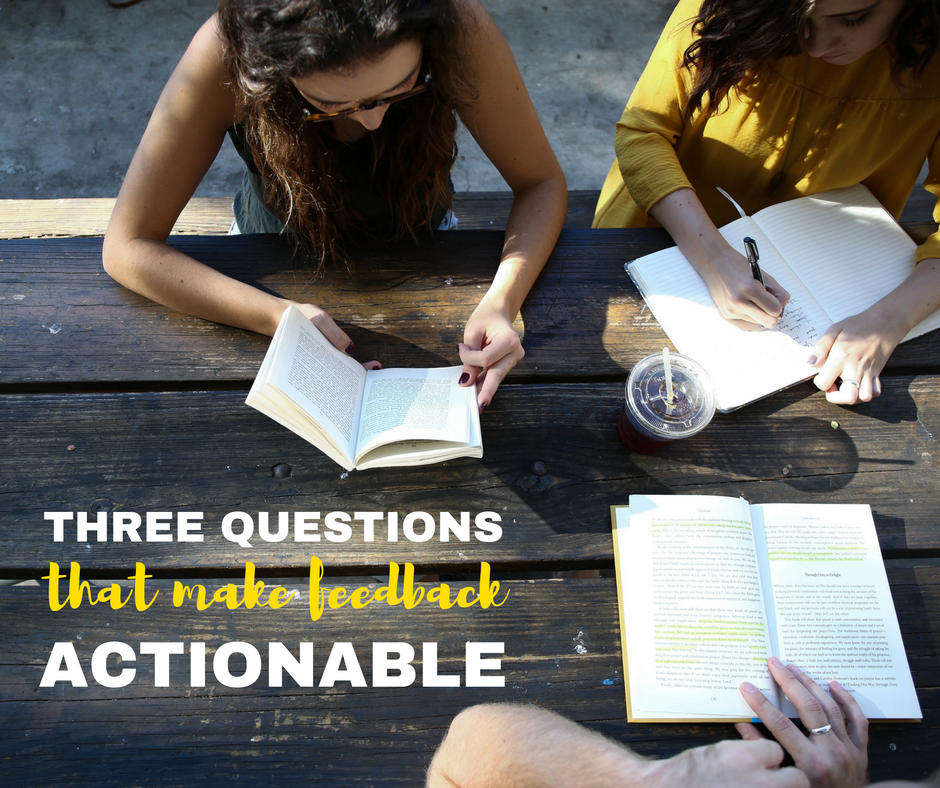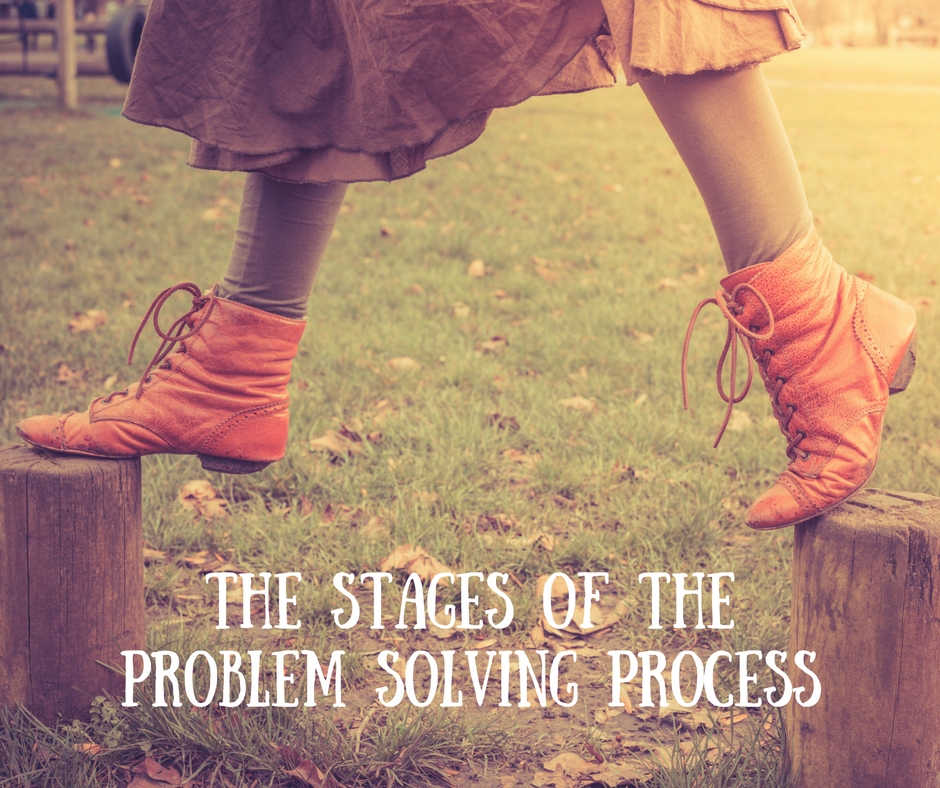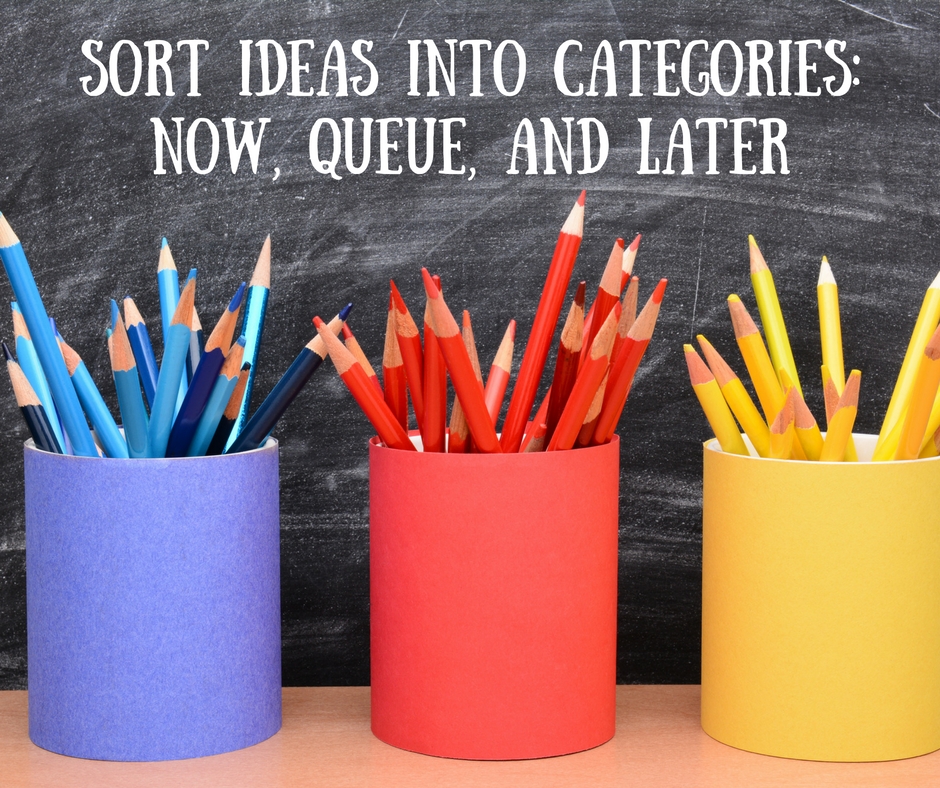by Naomi | Nov 3, 2016 | Creative Life

When you ask a friend or advisor for feedback, you’re both up against a number of challenges.
Your advisor:
- Doesn’t know all the ideas you’ve tried and tossed out
- Hasn’t researched, thought, and tinkered with this question or creation for as many hours as you have
- (Hopefully) Wants to give helpful feedback to move you forward without discouraging you
You:
- Have invested significant time and want that time to add up to successful results
- Have made the project as strong as possible, given your current perspective and skill set
- (Hopefully) Are passionate about your project, and therefore, you have skin in the game
Given the challenges, does it make sense for you to seek feedback at all?
You and your advisor are knowingly putting yourselves into a situation filled with the potential for misunderstanding and conflict. Why risk it?
Because you:
- Have invested significant time and need to understand how others might react to your creation once you release it into the world
- Have blind spots because of your current perspective and skill set, which others can see more clearly than you can
- Care about your project’s success, and therefore, are willing to tackle your ego, engage with honest feedback, and exercise your resilience through the revision process
Whether you’re writing a novel, developing an app, or designing a lesson plan, your creative process will yield stronger results if you seek feedback at key points along the way. Often when we seek feedback, we want to give our advisors room. So, we ask a wide-open question along the lines of, “What do you think?” However, when we’re on the receiving end of such a question, we immediately see the problem. The most likely answer to “What do you think?” in an emotionally fraught situation is, “Ummm…”
So, what might you ask instead?
Give your advisor an opportunity to read the section, play with the app, or review your lesson plan. Then, give these questions a try:
1. What do you know?
Answers to this question confirm how successfully you’ve communicated. Will your reader or user be able to navigate without you sitting beside him and explaining? For a lesson plan, try adapting this question to: What will a student know after this lesson? For other creative situations, adaptation might also be required. One strong substitute for this question in visual and musical arts can be, “What do you feel?”
2. What do you think you know?
Answers to this question provide insight about what your work might infer. Consider whether these nuances are desirable––and how you can play them up or remove them. Make sure that any information that you mean to make clear doesn’t show up in this more fuzzy category. Watch for opportunities, here, too. Sometimes an answer to this question will reveal a thematic layer or new possibility that opens up new depth in your work.
3. What do you want to know?
Answers to this question reveal the questions your work evokes. Sometimes these questions reveal aspects of the project that have not been fully realized. Other times, these questions confirm the desired impact of your work, or provide you with ideas for follow-up projects.
Of course, some feedback sessions call for a different set of questions. However, in many situations, this set of questions structures a productive conversation that allows for honest feedback. Your advisor will confidently be able to help you, and you will be able to absorb the feedback without becoming defensive.
Why seek feedback?
The value in seeking feedback from an advisor isn’t in having her fix the problems for you. In fact, given the time invested, even if your advisor is more experienced than you in general, YOU are the expert on your specific project. What you want from your advisor is his outside perspective, which is often helpfully informed. With that perspective, your advisor can help you identify problems. Then, you can set about resolving the problems through brainstorming, research, and iteration.
What project are you working on that would benefit from outside perspective? Who might you ask to review your work and answer these three questions? Try it out, offer your feedback in exchange, and see how your work develops.
by Naomi | Oct 17, 2016 | Creative Life

Do you have enormous goals on your mental or physical to-do list such as:
- Learn how to podcast
- Write a novel
- Run a half-marathon
- Learn to play the guitar
Projects such as these beg the question: Where should I start?
When learning to draw, the first task is to stop one’s mind from translating the concept “apple” into a symbol. We must see the real apple with all its curves and irregularities in order to accurately draw it.
In my experience, the same is true with goals. Our brains, amazing tools that they are, simplify complex projects into impossible-to-tackle placeholders. While we can pick up a guitar and start plucking strings, for most of us, the time spent isn’t likely to result in learning to play guitar.
Why?
- We haven’t clarified what we mean by “learn to play the guitar.”
- We don’t know where to start.
- We quickly lose heart when we can’t track or measure our progress.
Let’s turn these challenges into proactive steps, and see where they lead.
Clarify the Goal
In the Attic, we explore the heart of a project. In the Studio, we improvise to bring new possibilities into the world. However, the Workshop provides us with tools to give our loose idea-material structure. In the Workshop, one asks: What do I know? What do I need to know? What are the pieces of this project or this skill? Where might I start?
One major task of the Workshop is to determine the scope of our project. It’s one thing to learn to front a rock band, and an entirely other one to learn to strum campfire songs. When we clarify our project, we determine our focus. With focus, we can clearly see which actions will be most effective to help us reach our goal.
One of the best strategies for clarifying your project is to take a quiet moment, close your eyes, and picture success in detail.
- What will the scene look like on the day you achieve this goal?
- What will you see, hear, feel?
- What will you be physically doing?
Once you have a clear picture, capture the highlights on paper. This scene becomes your destination point, and helps you determine which actions are relevant, and which are not.
Determine Where to Start
While we want our destination to be a firm location, with creative projects especially, the path to the goal can vary widely. Consider an open space with many trails that end at a lake. There may be four or five possible starting points, and various trails with scenic points along the way.
In the end, our experience of “hiking to the lake” is singular. No matter how much we plan a hike or a creative project, something is bound to surprise us along the way. Ideally, we want to create a plan with enough structure to keep us moving toward our ultimate goal, while leaving room for surprise.
Ask Yourself:
- Where are my current circumstances with regard to this project?
- What do I hope to learn along the way?
- How much time and stamina do I have?
Track and Measure Progress Toward Your Goal
Each year when Society of Young Inklings begins the Inklings Book editorial process, we ask our mentors to choose a specific revision focus. For instance, the mentor and youth writer may focus on developing character through dialogue.
By focusing on dialogue, the youth writer sees improvement that can be specifically described. “My dialogue used to be x, and now it is y.” This clear growth builds confidence. While revising with a specific focus, writers often identify other weaknesses and fix them without becoming sidetracked. Contrast this approach with a general “I’ll fix everything that’s wrong” approach. You can see how rabbit trails and discouragement easily set in.
In order to track and measure your progress, be specific about what you’re tracking. Ask yourself:
- What external milestones are essential along the way?
Here, consider the achievements between start and finish, such as character profiles, a plot, a first draft, a critique session, a revision, etc.
- What internal milestones are essential along the way?
Here, refer to the question: What do I want to learn along the way? Break that goal into measurable steps. If you want to learn about developing believable characters, what is involved?
First Steps
If you do have a giant project on your to-do list, depending on your style, your first step may be to head into the Attic to figure out why this project is so important to you. Alternatively, your first step may be to hit the Studio to play around and find your general direction.
Somewhere, though, early on in the process, the Workshop becomes a necessary step. For most of us, the purpose of major projects such as writing a novel or running a half-marathon is to challenge ourselves to grow. Growth will happen naturally whether we make a plan or not, but we’re more likely to see the results we hope for if we understand what those results will look like—both externally and internally.
I look forward to hearing about your projects and successes! Make sure to share so we can cheer you on.
by Naomi | Sep 26, 2016 | Creative Life

Last week, I challenged my team of Inklings mentors to each invent his or her ideal creating space. I gave the group five minutes, and asked them to use one side of their paper to document their problem solving, and the other side to capture their actual idea.
If you have five minutes to spare, try this challenge yourself. If you don’t have time, think of a recent problem you solved. Try to remember beyond the solution to the actual thinking process involved.
Let’s Examine your Process
- How much time did you spend clarifying the challenge? Did you explore what “ideal space” meant before generating ideas?
- How much time did you spend brainstorming or exploring options? Did you stretch for unusual ideas?
- How much time did you spend reviewing your ideas and developing the ones that fit best?
- As part of formalizing your idea, did you create any sort of an action plan?
Give yourself a 1-5 score in these four stages of the problem solving process. Choose one if you hardly considered (or struggled with) the stage, and five if you handled the stage smoothly.
Stages of the Creative Process
- The first stage is Clarification. Here, we ask questions and explore current reality. We narrow our focus to make sure the idea-generation points in the right direction.
- The second stage is Ideation. Here, we generate ideas. The ability to brainstorm an abundance of ideas leads to novel solutions.
- The third stage is Development. Here, we identify promising ideas and refine them into truly workable solutions.
- The fourth stage is Implementation. Here, we create an action plan and get to work. Sometimes during Implementation, we discover another problem, which sends us back to the clarification stage.
Play to your Strengths
If you’ve been poking around this site, you may have seen and/or taken the Creativity Styles quiz. You likely know I’m passionate about helping people play to their strengths. So, you might be surprised when I say this: I believe that effective creative people develop skills in each of these stages, particularly in the ones that are most difficult for them.
It’s true that you’ll have more aptitude for certain stages depending on your creative style, but that doesn’t mean you get a pass on the others. Mastery comes from figuring out how to play to your strengths AND succeed in all four of these stages.
Do Your Blind Spots Help or Hinder You?
Where are your strengths? Do you have any blind spots? Write down what you notice. All of this thinking leads to this question: How might you boost your weaker problem solving skills in a way that appeals to your creative style?
You may be wondering: How does the creative problem solving process fit into the Writerly Play rooms? Great question! Each time you enter a room, you’ll likely circle through these stages at least once before you’re ready to move on to another room. Where you may bounce from room to room, the creative problem solving stages are generally tackled in order.
I’d love to hear your thoughts. When our Inklings mentors unpacked this experience, it was fascinating to witness firsthand how different we all are in our thinking processes. I gained particularly helpful insights from the mentors whose thinking was most opposite to my own. So, share away!
by Naomi | Sep 22, 2016 | Tools & Apps
My playlist is an eclectic collection of tools that help me approach my work as play. My hope is that they’ll do the same for you.

Object: Sorting ideas and options into now, queue and later categories.
What Didn’t Work: Keeping a loose mental list of all the books I wanted to read and ending up feeling forever behind, taking the next action on all the projects on my mind, and all the ones that anyone talked about on the most recent podcast that I realized I “really should do,” hoping that I’d recall a blog post or lesson plan when the opportunity to repurpose material arose.
My Aha! Moment: When I learned my primary creative style is Inventor, I dug deeper into what this style meant about my thinking. First, I learned I’m a visual thinker. No wonder databases and spreadsheets made my head hurt. I examined how the Inventor style expresses itself in my personal creative process, and realized that my strengths are in ideation and implementation. So, I have an idea and then I act. This loop repeats at speed. Projects layer on top of projects until I’m buried. My own deadlines are forced to defer to the “hard” deadlines provided by others, and I end up frustrated. The projects I care about most move along at a snail’s pace because I’m doing forty of them simultaneously.
I imagined how I’d like my process to work. I pictured a colorful machine with various chutes and conveyer belts all sending material to an “action zone,” where projects could be completed, wrapped in shiny paper, and sent on their way. What I needed was a tool that could queue up my ideas, allowing me to easily sort and resort them. Rather than immediately acting on new ideas, I needed to put them into the “machine” where I could see them lined up against all the queued ideas.
Enter Airtable. It’s a database, yes, but the data can be viewed visually. Many relationships can be built to categorize ideas and sort them based on the criteria of the moment. Re-ordering is as simple as drag and drop. My imagined idea machine might not exist, but with Airtable, I could build a close enough replica to manage and streamline my work-flow.
How I Play:
- I created bases for books, for ideas, and for my blog posts to start.
- I set up fields for images (such as cover images or blog post images) so when I viewed my bases as cards, they’d be visually appealing.
- I created categories so that I could sort the entries in the various ways I would want to see them. For example, in the book base I used “creativity,” “mystery,” and “literary fiction,” as a few of my categories.
- I also created a field called status. Here, I can sort ideas or books into “now,” “queue,” “consider,” and “finished.”
Player’s Notes:
- Airtable allows the user to create links between records. So, for instance, in the book base, I have a table for books and another for authors. Books and their authors can be linked, to make for additional sorting options.
- The sample bases in Airtable are entertaining and offer a fantastic introduction for new users. Try them out, have some fun, and let yourself play. Especially if databases aren’t your thing, approaching the process from a playful vantage point will help you blast past the difficult parts of getting your ideal system set up.
Take it to the Next Level:
- Zapier and IFTTT are two automation tools that work in collaboration with Airtable. This means, for instance, you can set up an email link so that whenever an idea pops into your mind or someone recommends a book, you can send the info to your base on the spot.
Sometimes tools that offer many options and functionalities can cause overwhelm. Rather than allow myself to lose focus by considering every possible function for Airtable, I started with a few that felt most immediate and important. If you try out the tool for yourself, I encourage you to start wherever you are. Let your system evolve. Don’t let perfect be the enemy of the perfect.
We hire professional organizers to help us conquer our closets because sometimes we simply need outside perspective. We often need similar help with our creative process. If you could use a strategy mentorship to help you tackle a thinking or work-flow mess, I’d love to help! Check out the opportunity here.

by Naomi | Aug 30, 2016 | Creative Life
In the Writerly Play Cafe, you’re invited to collaborate with others—giving and receiving feedback, problem-solving, and overcoming any creative blocks that may arise.
Creativity doesn’t happen in isolation. In fact, the most common definitions of creativity require that an idea isn’t only original, but useful. To determine usefulness, we look at a work’s impact on others. And thus, others are a key part of any creative act. That’s why we can’t forget the importance of the Writerly Play Cafe.
If you’re joining this series mid-stream and wondering what in the world the Writerly Play Cafe is, you might find it helpful to start at the beginning.
The Cafe rounds out our collection of mental spaces in the creative landscape of Writerly Play. Depending on your medium and your creative style, the Cafe may be your main work space. It may also be your least visited room. Whichever is true for you, it’s important to be aware of when we are in our Cafe and when we are not.
Even the most collaborative of art forms benefit from individual voices. At some point, we need to quiet all outside noise and listen to our own intuition. So, like the Studio and Workshop, I’ll invite you to think about the distance you need between your Attic and Cafe. You might only need a thin door. Or you might choose to set up your Cafe out in the back garden as I have.
I need the distance to give myself time to ask:
Do I need feedback right now?
What kind of feedback do I need, and from whom?
So, where will you place your Writerly Play Cafe? What type of doorway will invite your collaborative, social self out to play? Listen to the buzz of the Cafe, feel the warmth of community inside, and make your way inside.
Look around. Who is in your Writerly Play Cafe right now?
Do people come and go? Is it an invitation-only space? Are there nooks and crannies to quietly speak with one friend, or a wide, weathered table with plenty of seating for a crowd? What other items are in the space? A whiteboard? Snacks? Past successes on display?
The more you engage with Cafe thinking, the better you will become at processing and putting feedback to use.
The core skills in the Writerly Play Cafe include:
-
Asking for Feedback
-
Receiving Feedback
-
Applying Feedback
-
Giving Feedback
-
Discussing Options
-
Learning from Feedback
In order to play to your strengths while thinking in these ways, what tools, strategies or supplies ought to be in your Cafe? What tried-and-true strategies do you have? What kinds of tools or activities would you like to seek out? Add to your toolkit or list. And if you’d like to explore some additional possibilities, here’s my
recent list of Cafe tools and strategies.
Writerly Play is a tool to individualize, map and problem-solve the creative process.
Before you start work, you can use Writerly Play’s narrative structure to identify your strengths and weaknesses, choose strategies that will work well for you, and determine a starting place.
As you go, you can use Writerly Play to track your progress. Which rooms have you visited? What room might help next? In your chosen room, what tool or strategy is most likely to yield momentum? If you haven’t downloaded it already, use the form below to snag your Writerly Play map. Print it as many times as you like to map your way through a project.
Or, when you find yourself stuck, you can use the map to unlock new possibilities. Writerly Play is a powerful antidote to creative blocks. Rather than beating your head against the wall, trying to do the same thing over and over, you can try out a different space, a different approach.
Ultimately, the who, the what, and the where of Writerly Play will help you transform your creative development into a story. And by telling yourself that story, you will be able to find and maintain creative flow.
And that, my friend, is what I truly wish for you.
The world needs your voice, your perspective, the stories that only you can tell. We need your creative solutions and most importantly, your joy.






